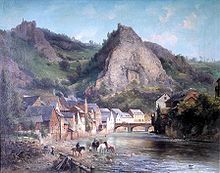German Gemstone Route
The German Gemstone Road is a 70-kilometer-long themed road around Idar-Oberstein an der Nahe , which connects places and landscapes that are characterized by gem processing and extraction. Many small businesses on the street invite you to visit and sell. There are also small museums and museum tunnels where agate was extracted.
The street was built in 1974.
Course of the German Gemstone Route
The Edelsteinstraße leads from Idar-Oberstein in two loops (large and small loop) around the city to the various sights and historical sites of gem processing, past many small manufacturers and dealers. The large circular route, marked by a stylized diamond, leads via Idar-Oberstein ( German Gem Museum , German Gem Exchange , Gem Experience World), Fischbach ( copper mine , mining circuit ) to Herrstein , Schauren , Allenbach , Kirschweiler (many gemstone companies and hobby grinding shops, gemstone fountains), Hettenrodt , Rötsweiler-Nockenthal , Algenrodt ( Steinkaulenberg gem mines ) back to Idar-Oberstein.
The region of the German Gemstone Route specializes primarily in hiking tourism. The Saar-Hunsrück-Steig runs through large parts . In Idar-Oberstein there is an approx. 10 km long hiking trail, the Nahe-Felsen-Weg, which has been recognized as a dream loop . The approx. 20 km long copper-jasper path begins in Hintertiefenbach . The approx. 9 km long Medieval Path , which was awarded Germany's most beautiful hiking trail in 2010, runs around the municipality of Herrstein . Along the Steinbachtalsperre, the Köhlerpfad crosses the communities of Sensweiler and Langweiler (near Idar-Oberstein) . In Veitsrodt there is a hiking trail called the Stone Guest Book, on which prominent visitors to the Edelsteinstraße have immortalized themselves. The Wildenburg game reserve is located in Kempfeld , where numerous wild animals can be visited, including wolves.
Gem Queen
The German gemstone queen is the representative of the German Gemstone Route and the gemstone and jewelry industry based in the vicinity of the city of Idar-Oberstein . She is elected for two years and cannot be re-elected.
Criteria for choice
Applicants for the election of the German Gem Queen are women aged 18 and over. You should live in the region of the German Gemstone Route and be interested in gemstones and the gemstone craft. Time availability and the willingness to represent their home country are necessary.
insignia
The gold necklace with the signet of the German Gemstone Route and the crown are among the insignia of the gemstone queen . In 1998 the headdress was redesigned as a diadem . It consists of 165 grams of yellow gold and has an adjustable carrying mechanism. It also contains several valuable gemstones, including a trapezoid-cut aquamarine , two citrines, and ten amethysts . The pendant on the forehead is set with blue topaz and diamonds . In addition, a sash is worn , and for special festive occasions also an regalia . Many well-known companies in the region were involved in the manufacture of the diadem.
The gemstone queens since 1976
|
|
|
Individual evidence
- ^ Idar-Oberstein: German Gemstone Road. In: idar-oberstein.de. Retrieved September 15, 2017 .
- ^ Deutsche Edelsteinstrasse, accessed on January 12, 2015. Accessed on February 11, 2015 .


